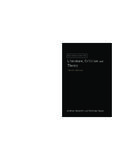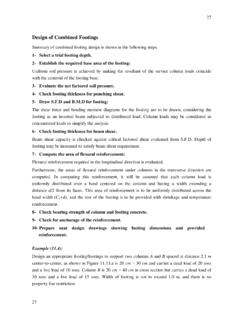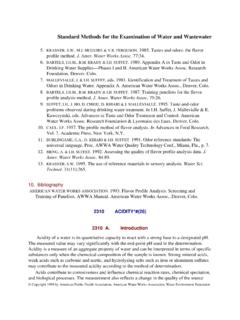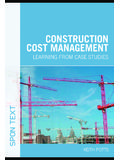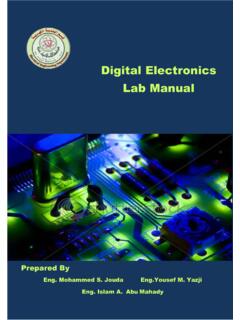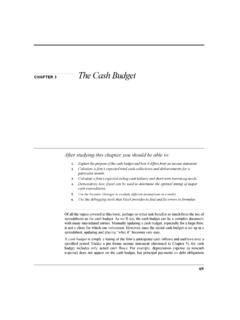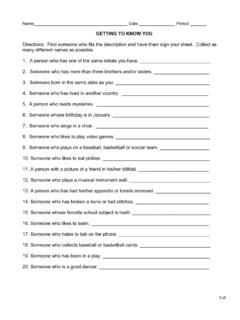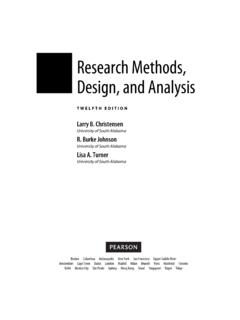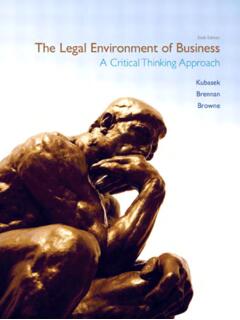Transcription of Accounting Information Systems - Islamic University of Gaza
1 AccountingInformationSystemsSEVENTH EDITIONJAMES A. HALLP eter E. Bennett Chair inBusiness and EconomicsLehigh Information Systems ,Seventh EditionJames A. HallVP/Editorial Director: Jack W. CalhounEditor-in-Chief: Rob DeweySr. Acquisitions Editor: Matt FilimonovEditorial Assistant: Lauren AthmerDevelopmental Editor: Maggie KubaleMarketing Manager: Natalie KingMarketing Coordinator: Heather McAuliffeAssociate Content Project Manager: Jana LewisManager of Technology, Editorial: Matt McKinneyMedia Editor: Bryan EnglandSr. Manufacturing Buyer: Doug WilkeProduction Technology Analyst: Starratt AlexanderProduction House: Cadmus CommunicationsPrinter: Edwards BrothersArt Director: Stacy Jenkins-ShirleyMarketing Communications Manager: Libby ShippPermissions Acquisition Manager: Roberta BroyerCover Designer: Itzhack ShelomiCover Image: iStock PhotoPrinted in the United States of America123451312111009 2011, 2008 Cengage LearningALL RIGHTS RESERVED.
2 No part of this work covered by the copy-right herein may be reproduced, transmitted, stored or used in any formor by any means graphic, electronic, or mechanical, including but notlimited to photocopying, recording, scanning, digitizing, taping, Webdistribution, Information networks, or Information storage and retrievalsystems, except as permitted under Section 107 or 108 of the 1976 United States Copyright Act, without the prior written permission of more Information about our products, contact us at:Cengage Learning Academic Resource Center,1-800-423-0563 For permission to use material from this text or product, submit arequest online Cengage Learning, a part of Cengage , the Star logo, and South-Western are trademarks usedherein under of Congress Control Number: 2009938064 ISBN-13: 978-1-4390-7857-0 ISBN-10: 1-4390-7857-2 Cengage Learning5191 Natorp BoulevardMason, OH 45040 USAB rief ContentsPreface xviiPart I Overview of Accounting InformationSystems 1 Chapter 1 The Information system .
3 AnAccountant s Perspective 3 Chapter 2 Introduction to TransactionProcessing 41 Chapter 3 Ethics, Fraud, and Internal Control 111 Part II Transaction Cycles and BusinessProcesses 151 Chapter 4 The Revenue Cycle 153 Chapter 5 TheExpenditureCyclePartI:Purchases and Cash DisbursementsProcedures 217 Chapter 6 TheExpenditureCyclePartII:PayrollProcess ing and Fixed AssetProcedures 265 Chapter 7 The Conversion Cycle 305 Chapter 8 Financial Reporting and ManagementReporting Systems 349 Part III Advanced Technologies in AccountingInformation 395 Chapter 9 Database Management Systems 397 Chapter 10 The REA Approach to DatabaseModeling 459 Chapter 11 Enterprise Resource Planning Systems489 Chapter 12 Electronic Commerce Systems 523iiiPart IV Systems Development Activities 571 Chapter 13 Managing the Systems DevelopmentLife Cycle 573 Chapter 14 Construct, Deliver.
4 And MaintainSystems Project 605 Part V Computer Controls and Auditing 663 Chapter 15IT Controls Part I: Sarbanes-Oxleyand IT Governance 665 Chapter 16IT Controls Part II: Security andAccess 703 Chapter 17IT Controls Part III: SystemsDevelopment, Program Changes, andApplication Controls 737 Glossary 773 Index 791ivBrief ContentsContentsPreface xviiAcknowledgments xxviDedication xxviiPart IOverview of Accounting InformationSystems 1 Chapter 1 The Information system : An Accountant sPerspective 3 THE Information ENVIRONMENT 4 What Is a system ? 5An Information Systems Framework 7 AIS Subsystems 9A General Model for AIS 10 Acquisition of Information Systems 14 ORGANIZATIONAL STRUCTURE 15 Business Segments 15 Functional Segmentation 16 The Accounting Function 19 The Information Technology Function 20 THE EVOLUTION OF Information system MODELS 24 The Manual Process Model 24 The Flat-File Model 25 The Database Model 27 The REA Model 28 Enterprise Resource Planning Systems 31 THEROLEOFTHEACCOUNTANT 31 Accountants as Users 32 Accountants as system Designers 32 Accountants as system Auditors 32
5 SUMMARY 33 Chapter 2 Introduction to Transaction Processing 41AN OVERVIEW OF TRANSACTION PROCESSING 42 Transaction Cycles 42 Accounting RECORDS 44 Manual Systems 44 The Audit Trail 50vComputer-Based Systems 51 DOCUMENTATION TECHNIQUES 53 Data Flow Diagrams and Entity Relationship Diagrams 53 system Flowcharts 57 Program Flowcharts 64 Record Layout Diagrams 67 COMPUTER-BASED Accounting Systems 67 Differences between Batch and Real-Time Systems 68 Alternative Data Processing Approaches 69 Batch Processing Using Real-Time Data Collection 71 Real-Time Processing 74 DATA CODING SCHEMES 74A system without Codes 74 ASystemwithCodes 76 Numeric and Alphabetic Coding Schemes 76 SUMMARY 79 APPENDIX 80 Chapter 3 Ethics, Fraud.
6 And Internal Control 111 ETHICAL ISSUES IN BUSINESS 112 Business Ethics 112 Computer Ethics 112 Sarbanes-Oxley Act and Ethical Issues 116 FRAUD AND ACCOUNTANTS 117 Definitions of Fraud 117 The Fraud Triangle 118 Financial Losses from Fraud 119 The Perpetrators of Frauds 120 Fraud Schemes 122 INTERNAL CONTROL CONCEPTS AND TECHNIQUES 128 SAS 78/COSO Internal Control Framework 132 SUMMARY 137 Part IITransaction Cycles and Business Processes151 Chapter 4 The Revenue Cycle 153 THE CONCEPTUAL system 154 Overview of Revenue Cycle Activities 154 Sales Return Procedures 160 Cash Receipts Procedures 163viContentsRevenue Cycle Controls 166 PHYSICAL Systems 170 MANUAL Systems 171 Sales Order Processing 171 Sales Return Procedures 174 Cash Receipts Procedures 174 COMPUTER-BASED Accounting Systems 177 Automating Sales Order Processing with Batch Technology 177 Keystroke 178 Edit Run 180 Update Procedures 180 Reengineering Sales Order Processing with Real-TimeTechnology 180 Transaction Processing Procedures 180 General Ledger Update Procedures 182 Advantages of Real-Time Processing 183 Automated Cash Receipts
7 Procedures 183 Reengineered Cash Receipts Procedures 185 Point-of-Sale (POS) Systems 185 Daily Procedures 185 End-of-Day Procedures 187 Reengineering Using EDI 187 Reengineering Using the Internet 188 Control Considerations for Computer-Based Systems 188PC-BASED Accounting Systems 190PC Control Issues 190 SUMMARY 191 APPENDIX 192 Chapter 5 The Expenditure Cycle Part I: Purchases andCash Disbursements Procedures 217 THE CONCEPTUAL system 218 Overview of Purchases and Cash Disbursements Activities 218 The Cash Disbursements Systems 225 Expenditure Cycle Controls 228 PHYSICAL Systems 230A Manual system 230 The Cash Disbursements Systems 232 COMPUTER-BASED PURCHASES AND CASHDISBURSEMENTS APPLICATIONS 234 Automating Purchases Procedures Using Batch ProcessingTechnology 234 ContentsviiCash Disbursements Procedures 239 Reengineering the Purchases/Cash Disbursements system 240 Control Implications 242 SUMMARY 243 Chapter 6
8 The Expenditure Cycle Part II: PayrollProcessing and Fixed Asset Procedures 265 THE CONCEPTUAL PAYROLL system 266 Payroll Controls 274 THE PHYSICAL PAYROLL system 275 Manual Payroll system 275 COMPUTER-BASED PAYROLL Systems 277 Automating the Payroll system Using Batch Processing 277 Reengineering the Payroll system 279 THE CONCEPTUAL FIXED ASSET system 281 The Logic of a Fixed Asset system 281 THE PHYSICAL FIXED ASSET system 283 Computer-Based Fixed Asset system 283 Controlling the Fixed Asset system 286 SUMMARY 288 Chapter 7 The Conversion Cycle 305 THE TRADITIONAL
9 MANUFACTURINGENVIRONMENT 306 Batch Processing system 307 Controls in the Traditional Environment 318 WORLD-CLASS COMPANIES AND LEANMANUFACTURING 320 What Is a World-Class Company? 320 Principles of Lean Manufacturing 320 TECHNIQUES AND TECHNOLOGIES THAT PROMOTE LEANMANUFACTURING 322 Physical Reorganization of the Production Facilities 322 Automation of the Manufacturing Process 323 Accounting IN A LEAN MANUFACTURINGENVIRONMENT 326 What s Wrong with TraditionalAccounting Information ? 326 Activity-Based Costing (ABC) 328 Value Stream Accounting 329 Information Systems THAT SUPPORT LEANMANUFACTURING 331 Materials Requirement Planning (MRP) 331viiiContentsManufacturing Resource Planning (MRP II) 331 Enterprise Resource Planning (ERP)
10 Systems 333 SUMMARY 334 Chapter 8 Financial Reporting and ManagementReporting Systems 349 THE GENERAL LEDGER system 349 The Journal Voucher 350 The GLS Database 350 GLS Procedures 352 THE FINANCIAL REPORTING system 352 Sophisticated Users with Homogeneous Information Needs 352 Financial Reporting Procedures 352 XBRL REENGINEERING FINANCIAL REPORTING 355 XML 355
